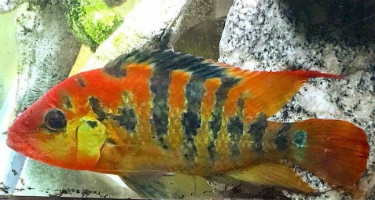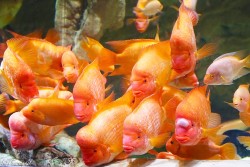Festae Cichlid for Sale | Mesoheros festae | Red Terror Cichlid | Amphilophus festae | Cichlasoma festae
 With its captivating color pattern and medium size, the cichlid Mesoheros festae offers an excellent option for the intermediate cichlid enthusiast. Formerly known as Cichlasoma festae, this Mexican native displays elegant rows of spots on a pinkish-orange background, earning it the common name red spotted cichlid. As a member of the Convict cichlid group, M. festae exhibits some similar care needs and temperament as its popular cousin. Yet this species boasts its own unique personality and behaviors when provided with a spacious planted tank, sandy substrate, and water parameters mimicking its subtropical homeland. Though territorial when breeding, these cichlids otherwise make lively community fish. For aquarists seeking an attractive and interesting New World cichlid, Mesoheros festae brings charming good looks and engaging behaviors that belie its relatively approachable care.
With its captivating color pattern and medium size, the cichlid Mesoheros festae offers an excellent option for the intermediate cichlid enthusiast. Formerly known as Cichlasoma festae, this Mexican native displays elegant rows of spots on a pinkish-orange background, earning it the common name red spotted cichlid. As a member of the Convict cichlid group, M. festae exhibits some similar care needs and temperament as its popular cousin. Yet this species boasts its own unique personality and behaviors when provided with a spacious planted tank, sandy substrate, and water parameters mimicking its subtropical homeland. Though territorial when breeding, these cichlids otherwise make lively community fish. For aquarists seeking an attractive and interesting New World cichlid, Mesoheros festae brings charming good looks and engaging behaviors that belie its relatively approachable care.For Sale Red Terrror cichlid fish approximately 1 and a quarter inches long. Amphilophus festae cichlids are a popular species of cichlids that are mainly found in Central America. They are named 'Red Terror' or 'Festae' because of their temperament levels that range from aggressive to very aggressive. Festae are vibrant, colorful scales and intelligent personality make you want to go and get them home. These cichlids dominate the fish tank and can cause damage to any fish or even the hand that feeds them. So, don't try and mess around with this beautiful fish! USA only. This is a wonderful fish from Ecuador and Peru, with an extant introduced population also thriving in Singapore possibly. They are known from both the Rio Esmeraldas in Ecuador and the Rio Tumbes in Peru.

Red Terror Cichlid Video
Cichlasoma festae species profile
Common Names
Cichlasoma festae is commonly known as the Red Terror Cichlid due to its vibrant red coloration and aggressive behavior.Etymology
The genus name "Cichlasoma" is derived from the Greek words "kichle," meaning 'thrush,' and "soma," meaning 'body,' referring to the body shape of these fish. The species name "festae" is likely a tribute to Mrs. Juanita Fest, the collector of the holotype specimen.Classification
Cichlasoma festae belongs to the family Cichlidae and is classified under the genus Cichlasoma, which was revised and reclassified as Herichthys. It is now scientifically known as Herichthys festae.Distribution
Cichlasoma festae is native to South America and is primarily found in the Pacific drainage of Ecuador and Peru, particularly in the Guayas and Tumbes river basins.Habitat
These cichlids inhabit slow-moving rivers, streams, and lagoons with rocky substrates. They often seek shelter among submerged rocks and underwater structures.Maximum Standard Length
Cichlasoma festae can grow up to around 12 to 14 inches (30 to 35 cm) in length.Aquarium Size
A spacious aquarium of at least 75 gallons or more is recommended for a single Cichlasoma festae, as they require ample swimming space and territorial boundaries.Maintenance
Maintaining Cichlasoma festae in an aquarium requires providing hiding spots using rocks, driftwood, and caves. Regular water changes and diligent filtration are essential to keep the water quality high due to their messy feeding habits.Water Conditions
These cichlids thrive in water temperatures between 72-82°F (22-28°C) and a pH range of 6.5-7.5. They prefer slightly soft to moderately hard water.Diet
Cichlasoma festae are carnivorous predators and primarily feed on live or frozen foods such as small fish, shrimp, and insects. A balanced diet with high protein content is crucial for their health and coloration.Behaviour and Compatibility
Cichlasoma festae are highly aggressive and territorial fish. They are best kept alone or with similarly robust and aggressive tankmates. Mixing them with peaceful or smaller species is not advisable.Sexual Dimorphism
Sexual dimorphism in Cichlasoma festae becomes apparent as they mature. Males typically develop more intense coloration, larger size, and longer fin extensions compared to females.Reproduction
During breeding, Cichlasoma festae become even more territorial. They lay their eggs on a flat surface and guard them vigorously. The parents work together to protect the eggs and fry, which hatch after a few days.Endangered List
Cichlasoma festae is not listed as endangered.References
Red Terror Tankmates and Tank SiRed Terror Tank Mates? | MonsterFishKeepers.com






